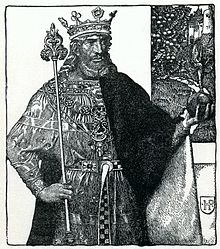Prospectus and Specimen of an Intended National Work



Prospectus and Specimen of an Intended National Work – poemat angielskiego dyplomaty i poety Johna Hookhama Frere’a[1][2], opublikowany w latach 1817-1818. Dzieło to potocznie jest nazywane The Monks and the Giants[1]. Stanowi opracowanie motywów z legend o Królu Arturze[3]. Utwór został napisany oktawą[4][5] (ottava rima), czyli strofą ośmiowersową pochodzenia włoskiego rymowaną abababcc, układaną po włosku jedenastozgłoskowcem (endecasillabo), a po angielsku jambicznym pięciostopowcem, czyli sylabotonicznym dziesięciozgłoskowcem, w którym akcenty są ustabilizowane na parzystych sylabach wersu. Frere’a uważa się za autora, który reaktywował oktawę w Anglii po długim okresie jej nieobecności[1].
- I've often wish'd that I could write a book,
- Such as all English people might peruse;
- I never should regret the pains it took,
- That's just the sort of fame that I should chuse:
- To sail about the world like Captain Cook,
- I'd sling a cot up for my favourite Muse,
- And we'd take verses out to Demerara,
- To New South Wales, and up to Niagara.
Prawdopodobnie z twórczości Frere’a oktawę przejął George Gordon Byron[1].
Przypisy[edytuj | edytuj kod]
- ↑ a b c d John Hookham Frere, [w:] Encyclopædia Britannica [dostęp 2017-02-13] (ang.).
- ↑ George Fisher Russell Barker: John Hookham Frere (1769-1846). historyhome.co.uk, 1889. [dostęp 2017-02-13]. (ang.).
- ↑ George Fisher Russell Barker: Frere, John Hookham, w: Dictionary of National Biography, 1885-1900, Volume 20. en.wikisource.org. [dostęp 2017-02-13]. (ang.).
- ↑ John Hookham Frere: The Monks and the Giants. Cantos I and II.. spenserians.cath.vt.edu. [dostęp 2017-02-13]. (ang.).
- ↑ Jacek Baluch, Piotr Gierowski: Czesko-polski słownik terminów literackich. Kraków: Wydawnictwo Uniwersytetu Jagiellońskiego, 2016, s. 266. ISBN 978-83-233-4066-9.
Bibliografia[edytuj | edytuj kod]
- John Hookham Frere: Prospectus and Specimen of an Intended National Work. Archive.org, 1842. [dostęp 2017-02-13]. (ang.).